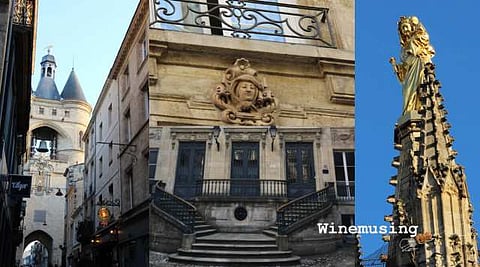
- Home
- About Us
- SOULIVITY TODAY Radio Show!
- COMMUNITY HUB
- GO SHOP by Soulivity!
- ColumnsColumns
- CultureCulture
- Lifestyle
- Contact Us!

The City
Bordeaux is probably one of the best-known wine regions in the world, so it is little surprise that it has become a popular wine tourist destination. You can choose to fully immerse yourself in the region by visiting the many beautiful Chateaux, touring your favorites and spending an afternoon in one of the tasting classes/tours on offer. Or if you are traveling with a group with diverse interests, this region has plenty to offer to appeal to even those who are not vinously inclined.
Here are just some of my suggestions for those who do not wish to leave the city boundaries:
La Cite du Vin
Whether you can make it out to the vineyards or not, La Cite du Vin has something to offer, even for the youngest visitors. This bold building was opened in 2016 and has been designed to be an iconic wine venue. It has an excellent wine discovery area that includes wine history, exploring different wine regions around the world and, as you might expect, interactive displays about the growing grapes and making wine. This permanent exhibition also has an excellent sensory exploration area that I would recommend to anyone.
There is also a wine store offering wines from around the world, temporary wine themed exhibitions, workshops (a few are in English) and restaurants. For those who want to get on top of it all, there is also tasting available in the fabulous Belvedere that gives you a 360opanoramic view of Bordeaux from 35 meters up on the eighth floor.
You can find more information about La Cite du Vin here: www.laciteduvin.com.
When you get to Bordeaux city – just walk….
The city has a history of wealthy benefactors and as such, there is plenty of fine buildings, city gates and monuments to enjoy. Even if you are not a passionate shopper, an easy start point is to walk down rue Sainte-Catherine which has been described as the longest pedestrian street in Europe and is bordered by stunningly decorative and well-preserved buildings.
It is very easy to let the city take you on a journey to unfurl its glories as there is something to discover around every corner. Some of the must-see highlights would have to be:
Place des Quinconces, a 12-hectare square that if you are traveling by public transport you will most likely come across as it has one of the transport hubs for the city. More attractive though is the looming Monument aux Girondins complete with fountains and gleaming stonework.
Miroir d'Eau sits between the river and the 18thcentury treasure, the Place de la Bourse. The Miroir was designed by Michel Corajoud and proves to be a magic, and refreshing, place for all ages as visitors gaze into the reflections that just a couple of centimeters of water over smooth granite can create or they can choose to make their own ripples as they are encouraged to walk and frolic in the water or in the jets of mist that cycle throughout the day.
While visiting the Miroir it quickly becomes apparent how very important the Garonne is to the success of the region. The Miroir provides a great viewpoint of the river and its considerable width, spanned by the Pont de Pierre built in 1810, particularly at sunset or of an evening. The boardwalk along the river is perfect for lovers, families or groups of friends to meander or sit in one of the seating areas.
Then there are the city gates that have stood silent witness to the growth of the vibrant city surrounding them. One of the most beautiful is the Porte Cailhau which dates back to 1494. The resplendent Porte de Bourgogne is the 1750's on the entrance to the city from the end of Ponte de Pierre. However, you might also find time to walk to Porte Dijeaux just near Place Gambetta.
When you are planning your route, it would be a shame not to visit the Grosse Cloche. The name 'Big Bell' fails to convey the fairytale appearance of the belfry that houses the 1775 bell, although those that were housed in the prison there would have felt their luck very Grimm indeed.
Include stops to see Cathedrale Saint Andre and the Grand Theatre and you will have traversed much of Bordeaux's alleys and boulevards.
Stop and enjoy the street vibe ….
It would take a very dedicated person to not succumb to sit at one of the outdoor tables spilling out of the restaurants and cafes lining squares, streets, and any space available. As you walk through Bordeaux, it is here that the true heart of the city is reflected as locals and visitors from near and far intermingle. And there are so many to choose from. After all, I have been reliably told that Bordeaux has the most places to eat per inhabitant than anywhere in Europe.
If you did not have enough opportunities to taste wine while visiting the vineyards, there are plenty of wine tasting opportunities available as well. There is even an urban wine trail put together by Bordeaux Tourism.
For those who want to make sure that they capture everything, there is a multitude of guided tours offered online or inquire at the Tourist Office (12 cours du XXX Juillet). There are even a couple of handy apps.
The next part of this series will explore things to do and see outside of the Bordeaux city.
—
This article was originally published in Winemusings, and can be found here.
